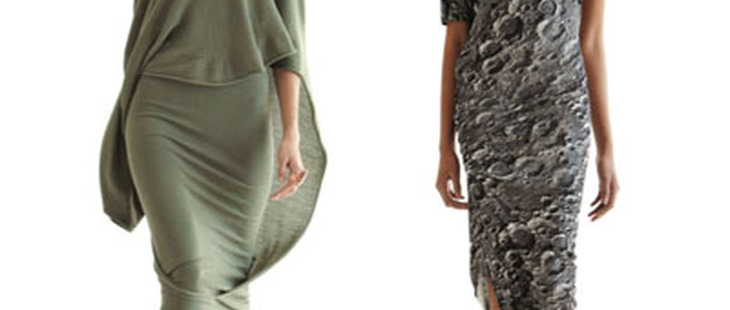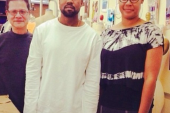
 From Jeremy Laing's Autumn/Winter 2011 Lookbook.
From Jeremy Laing's Autumn/Winter 2011 Lookbook.
The defining change in fashion this millennium isn’t that hemlines have risen, then dropped, or that pants have become impossibly skinny and widened like rivers again, or that innovative textures have replaced drastic shapes, or that prints have developed digitally beyond recognition. It’s that fashion itself has become fashionable. That it’s as cool a thing to like now as rock’n’roll was in the ’50s. That little girls want to be celebrity stylists. That you’re even reading this, probably.
“Yes, and honestly, that’s what I think the problem with fashion is!” says Jeremy Laing, vehement but so soft, his exclamation like almost anyone else’s ellipsis. “Fashion shouldn’t be so fashionable. None of it—the celebrity, the society—helps in the long run. It’s a game you have to play to keep up. I’d rather just be here, toying with fabric.”
It’s a slow, faded-summer morning and “here” is Studio Laing, where the 32-year-old designer and I sit on mismatched chairs in a white and naturally lit nook. A small table is his playground, heaped with fabric swatches in damp colours, and above it hang small artworks: one by General Idea, one by Shary Boyle, one by Brad Phillips, which he bought at a Hunter & Cook $50 sale, reading “Toronto The Greatest City” in bubble letters. “Yes, it’s black marker on white photocopier paper,” says Laing. “But, you know, context is king.”
Laing is half-Dutch, half-elfin, with a dreamy nerdling stare behind thick-ish vintage glasses, and if he says something you might hear at a social networking conference—“context is king?”—you can be sure he’s taking the piss. Then again, it’s rather true of his work. His womenswear is recognizable and beloved for its fluid, in-flux qualities, for the way each garment seems to take shape not only with the wearer but with her surroundings. His references have ranged from architecture in Florence to Bill Reid’s Haida prints, but the results are so thoughtful and abstracted that each “piece”—as per the industry lingo—truly does seem part of something larger. Not a fantasy world, exactly; Laing is after all pragmatic, describing design as “a collaboration between process, material, intent and resources.” No, the larger thing is more like a puzzle, one he’ll never solve himself.
“The clothes look best on you, not on the rack,” he says, “which I think is important. They derive their beauty from use. They’re not static, complete, perfect. It’s an approach I have and it’s part of my process”—here he pauses, characteristically, to amend a statement that might sound too final—“for better or for worse.”
 Jeremy Laing at Powerball 2011, of which he was co-chair. (Photo courtesy of Nolan Bryant/www.nolanbryant.com)
Jeremy Laing at Powerball 2011, of which he was co-chair. (Photo courtesy of Nolan Bryant/www.nolanbryant.com)
And so while other designers are reactionary, throwing out the pieces and starting over each season, bent on newness and trending, Laing is quietly evolutionary, building on his existing aesthetic with new perspectives. Over and over he describes what he does as “organic” and/or “emerging.” About things he’s not doing—say, a t-shirt line, or a resort collection—he will always and only say that “it’s not the right time.” He is the highest-profile designer working in Canada, surely. He’s also the one not collaborating with brands like Danier and ALDO, as are Greta Constantine, Mark Fast, and Denis Gagnon. His husband, Frank Griggs, does all his promotion, making him the only established designer I know of without a PR agency; when Laing does backstage interviews, he drily gives each reporter a different, though not untrue, soundbite about his “inspiration for the season.” Because, to Laing, what’s a season? Another stage in the game.
In 2002, a 23-year-old Laing had just graduated from Ryerson Fashion School and was off to New York, showing his first collection at a tiny gallery on the Lower East Side. He sold nothing to buyers, but got some press. When he debuted in Toronto, as part of a group show at S.P.I.N. Gallery (RIP), editors sat up straight. “I had heard whispers about this kid who worked for Alexander McQueen”—he had, in 2001, and continued periodically through 2003—“and was doing something really exciting,” says Bernadette Morra, then a Toronto Star fashion editor, now the FASHION Magazine chief. “Whenever someone had talent in Toronto, they stuck out like a sore thumb. So before the group show, I went to see him. He lived in a total starving-artist apartment in Chinatown, but the clothes were something else; they could have been from anywhere.”
“I remember hearing about him going to London to work with McQueen, who was super-exciting, and thinking that was so cool,” says Jaime Sin, who met Laing at Ryerson and is now his close friend, often DJing his shows and (twice) making his runway jewellery. “I didn’t know him particularly well when he launched his line, but I loved the designs from the get-go, and thought his decision to show in NYC was very savvy.”
Page 2 of 3
Laing’s early efforts were wrought from military materials, like burlap and parachutes, before recycling was in vogue (and he showed them on males, not females, years and years before James Franco and Marc Jacobs covered magazines in drag). This was no punk conceit: at age four, his family moved from Peterborough to a Canadian Armed Forces base in Germany, so he’d grown up with the stuff. By age 13, he was teaching himself how to sew on his mother’s machine; through adolescence he watched Fashion Television and Fashion File, becoming captivated, he says, “by all the smoke and mirrors.”
Even as a young designer—one almost immediately picked up by Holt Renfrew and critically lauded in New York—Laing seems to have been steady, not heady. “He wasn’t part of any scene, fashion or otherwise, and just liked things that were interesting,” says Rory “Them Finest” Johnstone, who ran in Laing’s Chinatown-based circles and has been DJing Big Primpin, the major gay night Laing and Griggs co-founded, for ten years. “From the beginning he worked hard and persevered quietly. There was a focus and joy in the work, and a disinterest in celebrity, coupled of course with a keen understanding that recognition helps bring work to the forefront.”
 From Jeremy Laing's Autumn/Winter 2011 Lookbook.
From Jeremy Laing's Autumn/Winter 2011 Lookbook.
Laing hasn’t lacked in recognition. American Voguettes have been attending his New York Fashion Week shows every season since 2005; he has a handwritten thank-you from Meredith Melling Burke next to the art on his wall. This year, he was nominated for the prestigious ANDAM Prize in Paris and worn (or at least bought) by Kate Middleton. But in the globalization-retardant, proudly stagnant fashion world, almost no designer can become major without moving to one of four capitals: New York, Paris, London or Milan. Laing, who owns his business and has no backers, isn’t moving.
“One thing I like about being here is that you’re not really part of any sort of big stream of fashion consciousness,” he says. “I kind of like that, but at the same time I kind of resent being an outsider. Like it’s that thing where you like it but you don’t at the same time. Sure, it would be great to have CFDA love and be an American darling.” Another one of those pauses. “Or not.”
When I suggest that he likes being an outsider, having chosen to operate outside of two cities rather than inside one, he laughs, then doesn’t disagree.
If he weren’t designing, Laing wouldn’t work in fashion at all. “I don’t love it enough,” he says simply. I guess that’s because he, as much a devotee of Walter Benjamin as of Dries Van Noten, understands it. “Fashion is, I think, like a closed loop, like in terms of what else is going on in the world.”
I recite the old perfect maxim: plus ca change, plus c’est la meme chose.
“That’s the big joke of it,” he says. “The point of the fashion industry is not to change, but to make more stuff.”
If he weren’t a maker himself, he’d have an antiques store; might still. It makes sense, given how thoroughly Laing’s learned his art and couture histories. Yet he is not in the least a nostalgic designer. His clothes feel contemporary without trying; they’re a boon to women who desire neither the retro silhouettes (and pre-feminist connotations) of then now for ridiculously changeable fads of now. Perhaps it’s because, for Laing, this “making stuff” feels more like letting it grow.
“You can make sketches and send them to a factory in Italy and they faithfully recreate your sketch and send you samples that are perfect and resolved,” he says. “Or you can start without a sketch and find a fabric that you like and you play with it and elaborate on something from before and you’re doing all your own patterns and you realize halfway through that this is a stupid way to do it, so why don’t you do this because it works in this other way, and then you end up with something else.”
If you can guess which kind of designer Laing is, you get no prize. “What I do is never that conscious. It’s never like, everything’s going to be neon lace this season. Even if I said that, it wouldn’t happen.” Pause. “But also, I would never say that.”
“Working with Jeremy isn’t much different from working with another artist,” says Niall McClelland, a contemporary artist repped by Client Roenisch who collaborated on Laing’s cool geometricky prints for the spring ahead. “He works with raw materials supplied to him in the same way, and produces something you couldn’t expect.”
 Runway images from Jeremy Laing's Spring/Summer 2012 collection.
Runway images from Jeremy Laing's Spring/Summer 2012 collection.
Page 3 of 3
 Runway images from Jeremy Laing's Spring/Summer 2012 collection.
Runway images from Jeremy Laing's Spring/Summer 2012 collection.
Laing kinda squirms under labels like “arty” and “intellectual,” but does self-identify as that buzzy in-between word, “artisanal.” It connotes manual skill along with thoughtful form, use with beauty. For a designer who cuts his own patterns, sometimes freehand, it suits. Design meets needs. Art, and artisanship, reconciles needs with desires. Skin with space. Use with beauty. If you look long enough, you’ll see all this in Laing’s clothing, which he sees as imperfect solution, and I see as reasons to look longer still.
The next pieces of the puzzle are turning around, slowly, in Laing’s mind. He wonders whether they—he and Griggs, his tanned, unmelancholy, perfect complement—should open a physical store in Toronto, or a worldwide virtual one. He seems entirely unresolved, and in no hurry, I say.
“Next season is four months away,” he says. “That’s the hurry.”
__
Sarah Nicole Prickett is Toronto Standard’s Style Critic














